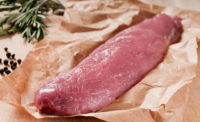Tech | Meat Science Review
HPP can help reduce E. coli in beef summer sausage

Traditional processing of summer sausage applies lower fermentation pH values (≤4.6) and higher thermal treatments after fermentation to meet U.S. Department of Agriculture’s Food Safety and Inspection Service (FSIS) performance standards for E. coli O157:H7 lethality (5D process; decimal reduction dose). Fermentation of summer sausages to lower pH values, along with higher cook temperatures following fermentation, have changed traditional summer sausage quality (texture and flavor). While alternate approaches were not available when the performance standards were mandated, the emergence of high-pressure processing (HPP) technology and its use in meat processing have provided an alternate, non-thermal processing technology to achieve pathogen reduction with minimal impact on product quality. Our goal is to evaluate the use of HPP subsequent to mild fermentation and lower than traditional thermal processing to augment the pathogen reductions achieved during fermentation and mild cooking and to meet FSIS performance standards.
In a previous article we wrote for this publication (November 2018), we discussed the ability to maintain summer sausage texture and color after HPP. While that article focused on product quality, the main goal of using HPP was its ability to reduce or eliminate pathogenic microorganisms that could survive mild fermentation and heat treatment or process deviations during manufacture of ready-to-eat (RTE) summer sausage. To help ensure microbiological safety, it is recommended that RTE meat products containing beef should achieve a 5D reduction of E. coli O157:H7 and Shiga-toxin producing E. coli (STEC). Processors using mild fermentation with a low degree of thermal processing currently operate under in-plant validations because of a lack of scientific literature validating alternative procedures to achieve a 5D process.
High-pressure processing is currently being used to improve the microbiological safety of raw fruit juices, deli meats and other high-water-activity foods. There is little information, however, on the efficacy of HPP when used in conjunction with fermentation and drying to reduce pathogen populations during production of low-water-activity processed beef sausage products. Therefore, our aim was to investigate the fate of E. coli O157:H7 and other STEC in mildly fermented, low-temperature thermally processed beef summer sausages using HPP for various hold times. To achieve our goals, all-beef sausage batter was inoculated with five strains of marked E. coli O157:H7 (rifampicin resistant) and a multi-strain cocktail of E. coli containing one strain each of O26, O45, O103, O111, O121 and O145 (each marked with Kanamycin resistance) and fermented to two pH levels using a commercial lactic acid bacteria starter culture. Sausages were then subjected to three mild heat treatments and two cooling methods, resulting in five treatment processes: pH 4.6 heated to 130º F with traditional chilling simulation (A); pH 5.0 heated to 130º F with traditional chilling simulation (B); pH 5.0 heated to 130º F with ice bath chilling (C); pH 5.0 heated to 120º F with ice bath chilling (D); and pH 5.0 heated to 110º F with ice bath chilling (E; Table 1). After thermal processing and chilling, samples from each treatment were assigned to one of four HPP times at 40° F and 84,000 psi: 0 seconds, 1 second, 2.5 minutes or 5 minutes.
Sausage pH immediately after the fermentation step was 4.6 (process A) and 5.0 (processes B-E); however, during the initial cooking step, the pH continued to drop, yielding an ultimate pH that was slightly lower than targeted: pH 4.5 versus 4.6 for process A and pH 4.8 versus 5.0 for processes B-E. Additionally, all processing treatments (prior to HPP) had water activity values (aw) ≤ 0.97 and moisture:protein ≤ 3.0. The initial batter was inoculated to 9.1 log CFU/g E. coli O157:H7 for all process treatments (A-E) and 8.9 and 9.0 log CFU/g STEC for process A and processes B-E, respectively. After fermentation to pH 4.6 populations of E. coli O157:H7 and STEC decreased by 1.6 and 1.5 log CFU/g, respectively. Process A, with an ultimate pH of 4.5 and 130° F thermal endpoint, both achieved total reductions of 6.3 log CFU/g of E. coli O157:H7 and STEC, exceeding the 5D process recommended by FSIS. Further reductions were not elicited by the use of HPP for hold times of 0 or 1 second for E. coli O157:H7; however, combining total process A with HPP for 150 or 300 seconds resulted in further reductions of E. coli O157:H7 of 7.1 log CFU/g and 8.1 log CFU/g, respectively. For STEC in process A, HPP hold times of 1, 150 and 300 seconds all resulted in total reductions ≥ 8.0 log CFU/g.

Processes B-E showed reductions of 0.6 log CFU/g E. coli O157:H7 and STEC after fermentation to a pH of 5.0. Through subsequent thermal treatment (130° F) and chilling, processes B and C reduced E. coli O157:H7 by 5.0 and 4.0 log CFU/g, and STEC populations by 4.9 and 4.0 log CFU/g, respectively. Although fermentation to a pH of 5.0 (4.8) and thermally processing to 130° F reduced E. coli O157:H7 and STEC, additional control measures were needed to achieve a 5-log reduction to meet current recommendations. With the processing parameters of processes B and C, additional HPP at 84,000 psi with a hold time of 1 second, 2.5 minutes or 5 minutes all resulted in reductions of both E. coli O157:H7 and STEC greater than 6.0 log CFU/g.
Summer sausages produced using process D (pH 5.0, thermally processed to 120°F) yielded a reduction of 1.2 log CFU/g after chilling and prior to high-pressure processing for both E. coli O157:H7 and STEC. The application of HPP (84,000 psi) for 1 second resulted in an additional 2.5 and 2.0 log CFU/g reduction for E. coli O157:H7 and STEC, respectively. However, holding the summer sausages under pressure for 2.5 or 5 minutes resulted in greater than a 6D process for both E. coli O157:H7 and STEC.
Thermally processing to 110° F (process E; pH 5.0/4.8) did not result in a net reduction of E. coli O157:H7 or STEC compared to post-fermentation counts. Furthermore, exposure to HPP (84,000 psi) for 1 second achieved 1.8 and 1.0 log CFU/g reduction for E. coli O157:H7 and STEC, respectively. However, similar to process D, holding the summer sausages from process E under high pressure for 2.5 min resulted in the recommended 5D process for both E. coli O157:H7 and STEC while holding under pressure for 5 minutes resulted in a greater safety window with an 8D process for both E. coli O157:H7 and STEC.
These results confirm that already validated processes for summer sausage manufacturing (fermentation to pH 4.6 and cooking to 130° F) resulted in a 5D process. In addition, the use of high-pressure processing at 84,000 psi for 2.5 or 5 minutes can increase the margin of safety up to an 8D process. Furthermore, a total process using a milder fermentation and thermal processing that incorporates high-pressure processing can meet the 5D reduction guidelines mandated for a beef summer sausage. The total process framework from this research can also be used to help ensure the safety of all-beef summer sausage products if a processing deviation occurs during fermentation or thermal processing. NP
Table 1. Process designation and process parameters
| Process | Process parameters (pH, target temperature and chilling) |
| A | pH 4.6, heated to 130º F with traditional chilling |
| B | pH 5.0, heated to 130º F with traditional chilling |
| C | pH 5.0, heated to 130º F with ice bath chilling |
| D | pH 5.0, heated to 120º F with ice bath chilling |
| E | pH 5.0, heated to 110º F with ice bath chilling |
Looking for a reprint of this article?
From high-res PDFs to custom plaques, order your copy today!





